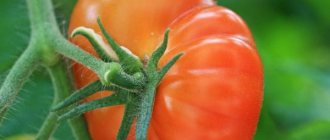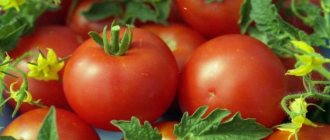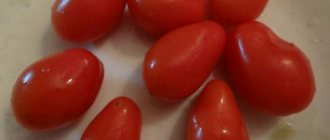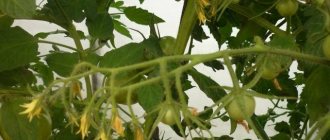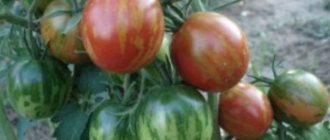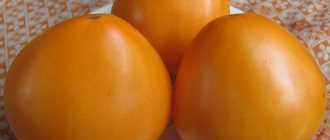Sowing
Seeds are sown in a tray or pots one and a half to two months before transplanting the seedlings into the ground.
The first harvest can be expected three months after sowing.
Harvest can be harvested after three months
The seeds are pre-treated with a manganese solution. The soil in the tray is moistened and the seeds are deepened into it by 1.5 cm.
Before planting seedlings in a greenhouse or open ground, prepare the hole - add organic fertilizers and immediately install pegs for support, so as not to disturb the root system later.
Tatyana Orlova (Vasilidchenko) (candidate of agricultural sciences):
Since the description of the variety indicates its average height of 1.7-1.8 m, it is better to grow it not on stakes (stakes up to 2 m high, taking into account penetration into the ground), but on a trellis, or on a garter along a twine with a free loop.
This variety requires pinching - cut off the side shoots and form a bush with 2 stems.
Care includes regular but moderate watering as the soil dries (once every 1-2 weeks). If possible, it is better to use drip or underground irrigation with warm, settled water. You can add a little ash to the water.
Another mandatory care measure is regular loosening and weeding. This is done as needed - as soon as a crust forms on the surface of the soil or the first weeds appear.
It is also recommended to mulch the soil in the garden bed with dried grass.
Obtaining seedlings
Tomato seeds Golden Eggs are planted at home. The seedlings are provided with the necessary conditions and care. Plants are prepared for transfer to a permanent location.
Planting seeds
Seeds of the Golden Egg variety are planted at the end of February or in March. Light fertile soil fertilized with humus is first prepared. The soil is prepared in the fall at a summer cottage or purchased ready-made soil in a store. Tomatoes can be planted in peat tablets or cassettes.
The soil must be disinfected to eliminate pests and pathogens. It is heated for 30 minutes in the microwave. After treatment, the soil is used after 2 weeks so that beneficial bacteria can multiply in it.
Containers 15-18 cm high are filled with soil. When using large boxes, tomatoes will require picking. You can avoid replanting by using separate 0.5 liter cups.
To disinfect, seeds are placed in a 1% solution of potassium permanganate for 20 minutes. Planting material is washed and planted in the ground.
Tomato seeds are planted to a depth of 0.5 cm. The containers are covered with film and transferred to a dark place. Germination of tomatoes occurs at temperatures above 20°C. When sprouts appear, the containers are moved to the windowsill.
Conditions for seedlings
The development of Golden Egg tomato seedlings occurs when certain conditions are met:
- daytime temperature from +23 to +25°C;
- night temperature +16°C;
- daylight hours 12-14 hours;
- watering with warm water.
The room where tomatoes are planted is regularly ventilated, but the plants should not be exposed to drafts.
The duration of daylight hours is increased by illumination. Fluorescent lamps or phytolamps are installed at a distance of 30 cm from the seedlings.
The soil is watered with settled water. It is best to use a spray bottle. When watering, you must ensure that water does not get on the leaves of the plants.
After the tomatoes have 2 leaves, they are picked into separate containers. Weak and elongated seedlings are eliminated. After picking, the tomatoes are watered every week.
In April, Golden Egg tomatoes begin to harden. First, open the window for 2-3 hours, then transfer the containers with plantings to the balcony. Gradually, the tomatoes will get used to natural conditions and will more easily tolerate planting in a greenhouse or open ground.
Characteristics of the tomato variety Easter egg
Gardeners most often choose high-yielding crops that are resistant to certain climatic conditions for planting on the site. These include the Easter Egg tomato, suitable for growing both in open ground and in a greenhouse.
Characteristics of the tomato variety Easter egg
The peculiarity of this tomato is the color of the fruit. The bright red skin has thin stripes of golden color, giving the tomato a resemblance to an Easter egg.
Characteristic
Easter egg is an indeterminate mid-early hybrid with high yield. When grown in a greenhouse, up to 6 kg of fruits are obtained from one bush. The best fruiting indicators are observed when the bush is formed with 2 stems. The description of the variety is worth special attention.
Description of the bush
The Easter Egg tomato bush is a vigorous grower. When grown in open ground, it can reach 1.7 m in height. In the greenhouse there are also two-meter specimens. Such parameters indicate the need for tying and pinching the tomato.
The fruits ripen in clusters of 6 pieces. The hybrid bears fruit until frost.
Description of fruits
The fruits of the Easter Egg tomato variety are classified as cocktail type. This is partly due to their small size and taste characteristics.
- fruits grow in clusters of 5-6 pieces;
- fruit weight - 70-90 g;
- bright red color with golden stripes;
- ovoid shape;
- taste sweet and sour;
- The pulp is juicy, with a large number of seed chambers.
The use of the fruits of the Easter Egg variety depends on the preferences of the gardener himself. Tomatoes are perfect for both fresh consumption and for preparing various dishes. Preservation of such vegetables is especially popular.
The thick skin of the fruit does not crack, and therefore they tolerate transportation well and are stored for a long time.
Features of cultivation
Unnecessary shoots must be removed
The Easter egg hybrid is a mid-early hybrid. After sowing the seeds, the harvest waits from 90 to 110 days. Growing seedlings is not difficult. Seeds are sown in small pots or trays with fertile soil. Before emergence, the containers are covered with polyethylene and placed in a warm place. With the emergence of seedlings, the seedlings are placed in the sun.
- For planting, light types of soil with preliminary drainage are used.
- Seedlings are planted in pre-disinfected soil. To do this, use a solution of potassium permanganate.
- The bushes are grown in formed beds, the width of which is 80 cm and the height is 30 cm.
Bushes are dug in parallel or in a checkerboard pattern. For growing crops, this feature does not matter. Since the bushes are vigorous, at the same time as planting, supports for the garter are installed. It is not recommended to do this later, as this work can lead to disruption of the root system of tomatoes.
In addition to tying, pruning is carried out. Removing leaves and unnecessary shoots will allow the plant to concentrate its energy on growing fruit.
Caring for seedlings deserves special attention. Watering should be moderate: excess moisture leads to root rot.
The first procedure is carried out 30 days after planting. Only warm, settled water is used, so before planting, care should be taken to install an open container for storing water near the planned growing site.
Regular weeding and fertilizers contribute to better yields. Fertilizing is often done with complex mineral compounds, although this variety of tomatoes is not picky about the type of fertilizer. The main thing is not to apply nitrogen fertilizers during the flowering period.
History of variety selection
Easter eggs are a rare variety that is not sold in every store. Most often, seeds are distributed by collectors and professional vegetable growers. According to them, the variety was bred by breeders from Bulgaria.
farmer.blog
The main differences between cocktail tomatoes
This new type of tomato appeared on the consumer market relatively recently. The ripening fruits of cocktail tomatoes are characterized by an unusual shape - plum, pear, pepper and a number of others. The color range is also varied - from yellow and orange to bright red.
Ripe fruits are small in size (up to 50 g), have a wonderful strong aroma and excellent taste: ripe tomatoes have enough sugar and a slight tomato sourness.
Due to their interesting shape and colors, these tomatoes are used to decorate the holiday table. The fruits are great for eating fresh as a snack.
Breeders do not stop working to improve the appearance and taste of cocktail varieties. Vegetable growers have already become interested in new species and are increasingly growing them in their beds and greenhouses.
dachampion.ru
Tomato Easter egg - description and characteristics of the variety
This variety of tomatoes appeared on the vegetable market not so long ago. They not only have a variety of shapes, but can also have different colors - there are fruits both yellow and red. The variety adapts to almost any soil and continues to bear fruit throughout the season. Therefore, more and more summer residents are choosing this type.
Differences
The ripe fruit reaches a relatively small weight - up to 50-55 grams, has a rich aroma and distinctive taste characteristics. Despite the sufficient amount of sugars, the tomato has a slightly noticeable sourness.
Thanks to the variety of colors, the variety is gaining immense popularity and becoming an important element of the festive table.
Advantages and disadvantages
Advantages:
- Increased yield.
- Earlier ripening of fruits, unlike most other varieties.
- Adaptability to any weather conditions.
- They do not fall off or crack.
The only drawback is the need to tie and trim branches.
Nuances of care
No special care required. It is recommended to plant seeds a couple of months before planting in the main soil. After replanting to a permanent location, the plant requires regular watering, pruning branches, loosening the soil, fertilizing, gartering, and getting rid of nearby weeds.
What else is good about this variety?
In terms of ripening time, this type of tomato is classified as a mid-early type, because about 105 days pass from the moment of the first shoots to the moment of harvesting the first harvest. In conditions of growth in central Russia, cultivation in closed greenhouses is recommended. The fruits are not prone to cracking even under the influence of weather conditions such as drought and high humidity.
How to grow?
Seeds are planted approximately a couple of months before the intended planting at the main growing site. They can be planted either in simple small boxes or in special peat containers. Before planting seeds in the soil, the seed material is treated with special means.
Sowing in primary soil is carried out at a depth of 1.5 cm, with additional watering using a sprinkler. Then the pots are covered with film until the first shoots appear. The primary dive occurs after the appearance of 2 leaves.
Seedlings are transferred to the main growing site only after a week's preliminary hardening. For these purposes, young seedlings are left in the fresh air for half an hour, and gradually increasing the time to 2 hours.
Before final planting, special holes are made in the soil with the addition of complementary foods - fertilizers. Next, the plants need to be regularly watered and tied up. Increased fertility is achieved by regularly loosening the soil.
This is done to achieve maximum balance in the development of the root system due to proper circulation of humidity and air.
As a result of proper care, the fruits ripen beautiful and of the correct shape.
Most gardeners have already appreciated their advantages and shared their opinions.
Characteristic
The Easter Egg variety is a cocktail variety. This category of tomatoes appeared not so long ago. The main characteristic feature is the unusual shape of the fruit, which may resemble pears, plums, peppers, etc. The color of tomatoes in this category will also please the eye - you can find tomatoes from soft yellow, greenish, up to rich red. The collected fruits will have a small weight - about 60 grams. They have a very strong aroma and excellent taste. So, these tomatoes contain a large amount of sugar and have a slight sourness.
Thanks to its characteristics, the Easter egg tomato can become a decoration for any table - both everyday and festive. The fruits are mostly used for fresh consumption, but are also suitable for canning.
Description of Tomato Easter Egg:
- Belongs to the indeterminant type;
- In terms of fruiting time – mid-early. After the first shoots appear, the harvest can be harvested after 3-4 months;
- It can grow in open ground conditions, but in the Moscow region it is grown exclusively in greenhouses;
- It has rather tall, spreading bushes that can reach 2 m in height;
- This tomato must be pinched, pinched, and systematically tied up;
- On the bushes you need to form 2-3 stems;
- The first ovaries are collected in inflorescences of brushes, each of which will grow about 6 tomatoes;
- Fruits that are ripe are egg-shaped. They are dense, fleshy, the color is red and yellow, the skin is dense and does not crack.
The fruits of the Easter egg tomato really look very much like painted eggs. The yield of the variety is quite extended. The fruits that ripen the latest will be even smaller than the first ones, but their taste will be sweeter.
Ripe tomatoes have good shelf life - they can be transported over long distances. Vegetables withstand the most common diseases.
The variety has a number of its pros and cons.
Among the positive qualities we can highlight:
- Increased productivity;
- Early fruit ripening;
- Normal development in any region of the country;
- Tomatoes are not prone to cracking or shedding.
The variety does not have any serious disadvantages.
How to Grow an Easter Egg
The agricultural technology for growing the variety is the same as for other varieties and hybrids of indeterminate type tomatoes. Tall bushes will require special care throughout the growing season.
Landing
Transplantation to a permanent place is the next crucial moment. Time - one and a half to two months before the expected start of harvest. Depending on the geographical location and climatic characteristics of the area, planting dates range from the second half of May to the beginning of June.
Depending on the specific conditions, as well as on the experience of the farmer and his readiness for the vicissitudes of the weather, the location is chosen: in a greenhouse or in open ground. Areas where potatoes, peppers, tomatoes and other nightshade crops were cultivated in previous seasons are unsuitable for planting. After these crops, the soil becomes significantly depleted of essential macro- and microelements.
Light soil types with pre-drainage are more suitable for planting. It is advisable to disinfect the soil by treating it with a 1% solution of potassium permanganate. Planting is carried out in recesses the size of peat pots on pre-formed beds, the width of which is 80 cm and the height is 30 cm.
Plants are placed in parallel or in a checkerboard pattern - it doesn’t really matter. Simultaneously with planting, supports or trellis structures for gartering bushes are installed. Doing this later is not recommended so as not to damage the roots.
Seedlings should be watered moderately with settled warm water, weeded and the top layer of soil around them regularly loosened to prevent root rot.
If you mulch - lay a layer of dried grass, straw or black non-woven fiber around each plant - the number of watering and loosening can be reduced. The mulch layer should be at least 5 cm thick.
Growing and forming bushes will require more attention and labor. Timely removal of leaves and excess shoots allows the plant to mobilize all the resources of nutrients for ovary and fruit growth. Therefore, the bush is usually formed into only two stems.
As the plant thus formed is stretched, its stems are tied to supports and trellises. Gartering, like pinching and pruning, is carried out throughout the entire growing season. They are also regularly fertilized with complex mineral fertilizers.
It is necessary to select fertilizers in such a way as to compensate for the lack of certain mineral elements - one, two or several at once. The deficiency of one or another element can be judged by the appearance of the plants.
Here are the special signs of deficiency:
- nitrogen - yellowed leaves, elongated stems, the trunk becomes soft, and the veins on the underside of the leaf acquire a bluish tint;
- phosphorus - the stem becomes stiff and brittle, and the leaves curl inward, the color of the plant changes to purple;
- potassium - the leaves darken, curl into a tube, brown spots appear along the edges, forming a border.
You can make up the fertilizer yourself or purchase it ready-made in the form of a complex fertilizer. Energen, which is not produced on the basis of coal, has proven itself well, which is why it is quite rightly classified as a fertilizer of natural origin. It contains microelements based on sulfur and potassium salts of humic acids. It has an excellent effect on the active growth of plants throughout the growing season, increases productivity and increases fruiting time.
Features of cultivation and possible difficulties
The Easter Egg variety does not have any exceptional growing features that are different from other indeterminate type tomatoes. This process will not cause any difficulties even for novice amateur gardeners.
The main thing is to strictly adhere to a well-developed scheme, observing the order and timing of all manipulations with plants:
- From the moment of sowing the seeds until the seedlings are transferred to the ground, at least 60 days must pass.
- It is necessary to carry out pinching and formation of the bush in time.
- Depending on the condition of the plants, fertilize periodically.
Diseases and pests
The variety is resistant to most tomato diseases. This circumstance is noted by almost all gardeners who cultivated the Easter egg. Even to the eternal scourge of all nightshades - the tobacco mosaic virus. The variety also successfully resists many pests.
Due to excess moisture at low temperatures, blackening of the fruits is possible. The occurrence of late blight can be prevented by selecting a well-ventilated and sunny place for planting. If necessary, use a fungicide.
Variety care
Fruiting of tomatoes depends on the supply of moisture and nutrients. According to reviews, Golden Egg tomatoes are unpretentious in care and do not require pinching. Low-growing bushes are tied at the top to a support.
Watering plants
Tomatoes are watered once or twice a week, taking into account weather conditions and their stage of development. The water is pre-settled in barrels and added in the morning or evening.
Watering scheme for Golden Egg tomatoes:
- before the formation of buds - every 3 days with 3 liters of water per bush;
- during the flowering period - 5 liters of water weekly;
- during fruiting - 2 liters of water twice a week.
A sign of a lack of moisture is yellowing and curling of the tops. With insufficient moisture, the inflorescences begin to fall off. Excess moisture slows down the development of tomatoes and provokes the development of diseases.
After watering, the soil is loosened to a depth of 5 cm so as not to damage the roots of the tomatoes. Mulching with peat or straw will help maintain soil moisture.
Fertilizer application
Tomatoes are fed with organic or mineral substances. During the season, 3-4 treatments are carried out.
For the first feeding, 0.5 liters of slurry is required. It is added to a 10-liter bucket of water, and the resulting solution is poured over the tomatoes at the root. The consumption of the product for each plant is 1 liter.
When the ovaries are formed, tomatoes are treated with a solution based on phosphorus and potassium. Phosphorus is responsible for the transport of nutrients in the plant body and the development of the root system. The final taste of tomatoes depends on potassium.
An effective way to feed is to spray the tomatoes on the leaves. To prepare a solution for foliar treatment, take components with phosphorus and potassium in an amount of 10 g each.
Between treatments of tomatoes there is a gap of 2-3 weeks. You can replace minerals with wood ash.
Protection from diseases and pests
According to the description, Golden Egg tomatoes remain resistant to major crop diseases. To protect plantings from late blight, they are treated with Ordan. Based on it, a solution is prepared, which is sprayed onto the plants leaf by leaf. Treatment is carried out every 10-14 days and stopped 20 days before harvesting.
When attacked by pests, the aboveground part of the tomatoes is damaged and the yield decreases. Insecticides are used against insects. Among the folk remedies, dusting with tobacco dust and watering with garlic and onion infusions are effective.
Planting and care
For those wishing to grow tomatoes, the seeds are sold unprocessed, as it is a variety and not a hybrid. The gardener must provide the seed with protection from rot and mold. To do this, the seeds are soaked for 20 minutes in a 1% solution of potassium permanganate, then washed and immersed in any growth stimulator (Silk, Epin, aloe juice, Humate, succinic acid). Seeds are sown without waiting for them to peck. Plants treated with the stimulant sprout quickly, do not suffer from blackleg, and are resistant to pulling.
Care in open ground or a greenhouse consists of watering, pinching and two feedings:
- the first - during mass flowering;
- the second - during mass setting and filling of fruits.
For fertilizing, use Kemira for tomatoes fertilizer or any other complex fertilizer that includes macro- and microelements.
The nuances of growing in open ground and in a greenhouse
This tomato variety was bred for cultivation in open ground. This is exactly how it is cultivated in the southern regions of Russia with a relatively mild and, most importantly, predictable climate. The nuances here come down to ensuring a supply of warm, settled water for irrigation, as well as effective drainage of the beds in case of prolonged or heavy rains. Of course, care should also be taken to ensure the reliability of the supports so that they can withstand gusty winds and erosion.
In regions located to the north, it is advisable to grow Easter eggs under film. Even in the Moscow region or central Russia, it is worth protecting these generally unpretentious tomatoes from hail, hurricane winds and other vagaries of nature.
In this case, you need to carefully monitor the temperature and humidity level in the greenhouses. The soil must not be over-moistened. Periodically ventilate and loosen the soil. One more nuance: in the greenhouse you should not overuse mulching to avoid mold and rot.
Letter of recommendation
The variety has an average ripening period. From the moment the first shoots appear until the ripe fruits are harvested, approximately 3.5 months pass. Izvol is suitable for both open beds and closed greenhouses. Older plants reach one and a half meters and are characterized by increased branching.
The shoots grow strong and large. There is no help in pinching them and tying them to a support or neighboring branches. The ovaries with future fruits are tied together with 4 neighboring ovaries.
During the ripening process, the fruit takes on a shape similar to an Easter egg, which is why it got its name. Often the color of a ripe tomato becomes reddish with yellow stripes. The ramp of the fruit has a dense structure, and their ripening continues until the end of the season. The most recent gifts of Pomona may be slightly smaller, but also sweeter in terms of sweetness.
Ripe tomatoes are often used fresh, but are also great for canning. The variety tolerates transportation very well and is practically not deformed. Older plants have proven resistance to major tomato diseases.
What are cocktail tomatoes?
You may be interested in: Tomato “Amur Tiger”: description of the variety, reviews
The fruits of the varieties of this group are very similar to the cherry tomatoes already well known to summer residents. Tomatoes are also collected in clusters of different sizes and are characterized by high decorative qualities. Cocktail tomatoes differ from cherry tomatoes mainly only in size: they are slightly larger. On each bunch of tomatoes of this variety can form from 5 to 20 fruits with a bright, eye-catching color.
The yield of cocktail varieties is quite good. In any case, they are superior to Cherry in this regard. The advantages of such tomatoes, among other things, include the simultaneous ripening of fruits on the cluster. Therefore, harvesting is convenient.
You may be interested in: Mamluk cucumber: description with photo
In most cases, cocktail tomatoes are large in size; the predominant number of varieties can be described as “tall”. But sometimes domestic summer residents also grow determinate tomatoes of this variety. Breeders have developed varieties of cocktail tomatoes, both early, mid-season and late.
Harvesting and application
The Easter egg usually begins to fructify at the end of July. Ripening in clusters of 5-7 pieces continues until the first frost. Thus, for about a month, fresh tomatoes can be served directly from the garden to the table served for a buffet or cocktail. The excellent taste of these festively bright tomatoes is noted by almost everyone who has had the chance to try them: dense, meaty, sweet with a slight sourness and a specific tomato aroma. Many people note that by the end of the season the fruits become smaller and sweeter.
Small tomatoes are suitable for whole-fruit canning. The dense skin is resistant to cracking and mechanical damage, so the fruits tolerate transportation and long-term storage in a cool and dry place. But in terms of juice or paste production, the Easter egg is inferior to large-fruited tomato varieties.
Features of cultivation
Unnecessary shoots must be removed
The Easter egg hybrid is a mid-early hybrid. After sowing the seeds, the harvest waits from 90 to 110 days. Growing seedlings is not difficult. Seeds are sown in small pots or trays with fertile soil. Before emergence, the containers are covered with polyethylene and placed in a warm place. With the emergence of seedlings, the seedlings are placed in the sun.
Transplantation into a greenhouse is carried out in May, and into open ground - no earlier than the first ten days of June. The earth, like the air, must be well warmed up: sudden cold snaps can destroy plants.
- For planting, light types of soil with preliminary drainage are used.
- Seedlings are planted in pre-disinfected soil. To do this, use a solution of potassium permanganate.
- The bushes are grown in formed beds, the width of which is 80 cm and the height is 30 cm.
Bushes are dug in parallel or in a checkerboard pattern. For growing crops, this feature does not matter. Since the bushes are vigorous, at the same time as planting, supports for the garter are installed. It is not recommended to do this later, as this work can lead to disruption of the root system of tomatoes.
In addition to tying, pruning is carried out. Removing leaves and unnecessary shoots will allow the plant to concentrate its energy on growing fruit.
Caring for seedlings deserves special attention. Watering should be moderate: excess moisture leads to root rot.
The first procedure is carried out 30 days after planting. Only warm, settled water is used, so before planting, care should be taken to install an open container for storing water near the planned growing site.
Regular weeding and fertilizers contribute to better yields. Fertilizing is often done with complex mineral compounds, although this variety of tomatoes is not picky about the type of fertilizer. The main thing is not to apply nitrogen fertilizers during the flowering period.
How to care for a plant?
Seeds and seedlings are prepared and planted in the same way as other varieties of tomatoes. The rules of care are:
The stems are tied to a pre-installed support, since the bushes are tall. It is advisable to form the bush into 2 or 3 stems so that the fruits are larger. The variety is watered by drip or, if this is not possible, at the root. It is better not to spray plants from above, especially in the heat. This will lead to the leaves drying out and falling off, and the fruits to develop poorly. Fairly resistant tomatoes still need to be protected from diseases and harmful insects
For this purpose, insecticides and fungicides are used. Watering should be treated with special attention so as not to lose the harvest.
Tomato Easter egg: description of the variety, how to grow it with photos
The plants are especially decorative because they have a long cluster of 20-40 red fruits, which, due to their high sugar content, have a very sweet taste. A new mid-season salad variety of English selection. The growing season is 110-120 days. The plant is medium-sized, 1.2 meters high, forms up to 8 clusters. The fruits are flattened-oval, red-brown in color, fleshy, with small seed nests, weighing more than 150g. The taste is excellent. It has genetic resistance to the main diseases of tomatoes, tolerance to low light and temperature changes. An ultra-early ripening low-growing variety, intended for cultivation not only in open ground, but also in flowerpots, on window sills, on balconies and even in winter gardens. Vitebsk. I can send it by mail. I sowed in the spring as expected. But in winter we also buy greenhouse tomatoes, so you can try planting them now. Or wait for spring - at your discretion. Answer to:
Vitebsk. I can send it by mail. I sowed in the spring, as expected. Breeds: Welsumer, Astrolorp black, Curly, Barnecked, Plymouth rock blue, Chinese silk, Phoenix, Favirolle and Brahma. And if each egg is in a newspaper and in a container, then wrap the container with some kind of rag... and warn at the post office that the product is very breakable, so they should be careful... maybe we can try? Do you keep eggs in an incubator? We live in Senica, and the eggs themselves are in Lepel, we can help with delivery to Minsk. Advertisement Chickens, quails, quails, hatching eggs, Gomel. Sale of chickens, quails, quails, hatching eggs, Gomel. Selling Birds Gomel - AdMir message board Gomel - 465032 Chickens: Oryol calico, fawn orpington, austrolorp, dwarf Leghorn B-33, dwarf bantams.
Tomato Golden Eggs - description and characteristics of the variety
The emergence of new varieties of tomatoes continues to be of great interest to gardeners and summer residents who grow various crops for their families, and to entrepreneurs who have established vegetable businesses. Of course, not all new products can gain popularity. However, when a new variety with the sonorous name Golden Eggs recently appeared, it was appreciated by everyone who had already received these fruits, appreciating their unpretentiousness during the growth period and increased productivity, and then tasted it.
Siberian breeders bred this variety so that in colder climates people could have tasty tomatoes on their tables. Therefore, Golden Eggs are practically not afraid of frost, they grow well in open ground, but it is still preferable for a large harvest to grow these tomatoes in greenhouse conditions, especially since they are very compactly placed in the garden with a high yield. As growing practice has shown, in greenhouse conditions the stems grow very intensively, and it is necessary to tie them up.
How to grow?
Seeds are planted approximately a couple of months before the intended planting at the main growing site. It is not forbidden to plant them either in simple small boxes or in special peat containers. Before planting seeds in the soil, the seed material is treated with special means.
Sowing into the main soil is carried out at a depth of 1.5 cm, with additional watering through a sprinkler. Then the pots are covered with film until the first shoots appear. The primary transplantation is carried out after the appearance of 2 leaves.
The seedlings are transferred to the main place of cultivation only after a preliminary week of hardening. For these purposes, young seedlings are left in the fresh air for half an hour, and gradually increasing the time to 2 hours.
Before final planting, special holes are made in the soil with the addition of complementary foods - fertilizers. Therefore, the plants need to be watered and tied up regularly. Increased fertility is achieved through regular loosening of the soil. This is done to achieve maximum balance in the development of the root system due to proper circulation of humidity and air.
As a result of proper care, the fruits ripen beautifully and have the correct complexion. Most gardeners have already appreciated their advantages and shared their opinions.
Features of tomato Easter egg
The Easter Egg tomato is a popular variety from the cocktail group. Its advantages include original appearance, delicate taste, and high yield. The strong skin does not crack when ripe. Beautiful and tasty fruits will perfectly complement the menu and decorate the table, and due to the density of the cover, they are well suited for canning.
Features of tomato Easter egg
Description
Tomatoes of this variety have an oval shape and an interesting color.
In appearance, the fruits really resemble Easter eggs (besides, they have the right size). Their weight is from 50 to 70 g. At the end of the ripening period, they become slightly smaller (up to 30-50 g).
The taste characteristics are the best. The tomato is quite sweet, but has a slight sourness and a subtle fruity flavor. Despite its high density, the skin is not at all tough.
Features of the variety
The tomato is an early ripening one. It is suitable for growing in the southern and middle zones.
In the south it is grown in open ground, and in the middle zone greenhouses are more often used (but they are also grown in open ground).
Tatyana Orlova (Vasilidchenko) (candidate of agricultural sciences):
Early ripening tomato varieties are most suitable for growing in regions where summers are short. In the southern regions, the long growing season makes it possible to grow not only early-ripening varieties, but also late-ripening ones, which ripen 115-120 days after germination.
The bush is tall, usually up to 1.7-1.8 m, but sometimes reaches 2 m.
Sowing
Seeds are sown in a tray or pots one and a half to two months before transplanting the seedlings into the ground.
The first harvest can be expected three months after sowing.
Harvest can be harvested after three months
The seeds are pre-treated with a manganese solution. The soil in the tray is moistened and the seeds are deepened into it by 1.5 cm.
Before planting seedlings in a greenhouse or open ground, prepare the hole - add organic fertilizers and immediately install pegs for support, so as not to disturb the root system later.
Tatyana Orlova (Vasilidchenko) (candidate of agricultural sciences):
Since the description of the variety indicates its average height of 1.7-1.8 m, it is better to grow it not on stakes (stakes up to 2 m high, taking into account penetration into the ground), but on a trellis, or on a garter along a twine with a free loop.
This variety requires pinching - cut off the side shoots and form a bush with 2 stems.
Care includes regular but moderate watering as the soil dries (once every 1-2 weeks). If possible, it is better to use drip or underground irrigation with warm, settled water. You can add a little ash to the water.
Another mandatory care measure is regular loosening and weeding. This is done as needed - as soon as a crust forms on the surface of the soil or the first weeds appear.
It is also recommended to mulch the soil in the garden bed with dried grass.
My hit parade of yellow tomatoes
For some reason, yellow tomatoes taste better to me than red ones, and I want to share the names of my favorite yellow tomatoes. I won’t bore you with discussions about the benefits of the carotenoid pigment lycopene contained in them, but will simply show pictures.
"Persimmon".
Moderately sweet and juicy. The color is more orange. Excellent taste! Ripens quickly and amicably.
Rice. 1 The “Persimmon” fruits are almost all the same, both on the lower and upper clusters, weighing about 400-500 g. The skin is without flaws. Good for salads, sauces, but not suitable for canning whole fruits, because the fruits will not fit into the jar.
Rice. 2 The pulp is sugary, but at the same time dense, like a real persimmon.
Rice. 3 Not capricious in cultivation, does not require fanatical stepsoning. I don’t tie up clusters with full fruit. Bush up to 1.5 m, best grown in a greenhouse.
Rice. 4 Persimmon seedlings May 8, sowing March 13. The first fruits began to turn yellow after 135-140 days from sowing.
"Truffle yellow"
It is eaten instantly - moderately sweet, moderately juicy, very tasty, so you can eat it in kilograms!
Rice. 5 “Truffles” are also all the same, as chosen, weight about 150 g, sometimes 200 g. It looks beautiful in preparations, and is also good for salads.
Rice. 6 The pulp is tender and dense, like that of “Persimmon”. There are no blemishes on the skin.
Rice. 7 Resistant to late blight, there is almost no need for pinching. It can be grown both in a greenhouse (the height will be about 1.5 m) and in open ground (it will be about 70 cm in my experience).
Rice. 8 “Yellow truffle” I also sowed on March 13, but it began to turn yellow 145-150 days after sowing.
“Golden Bull”
The “Golden Bull” has a rather lemon color. Unusual in its tactile sensation on the tongue, this variety reminds me of melon. It’s also very tasty, moderately sweet, but what can I say, it’s just a mini-melon!
Rice. 9 Weight about 300 – 350 g. Salad purpose.
Rice. 10 Dense pulp, thin skin. If it sits longer to ripen, it will acquire a more orange color and a red blotch will appear at the bottom.
Rice. 11 For greenhouses, height about 1.8 - 2 m. Requires gartering of clusters with the largest fruits, timely pinching. It begins to turn yellow 140-145 days after sowing.
Rice. 12 The seedlings of the “Golden Bull”, I would say, are capricious. The trunks are not strong, but thin sissies. However, such seedlings also make excellent powerful bushes.
"Golden King"
It’s also not bad, it’s beautiful, but it tastes like an ordinary tomato. However, I grow it because it is unpretentious, all tiers are tied quickly enough, and the fruits are very large.
Rice. 13 Weight 300-400 g. Salad. But there are stripes on the skin, you have to cut it off for salads, I don’t like coarse fibers in salads, and in general the skin is a bit thick for my taste.
Rice. 14 The pulp is juicy, similar in cross-section to the “Golden Bull”, but it does not taste like melon, but just an ordinary tomato.
Rice. 15 In the greenhouse, the height is about 1.8 - 2 m, out of curiosity I planted excess seedlings in open ground, they grew up to 60 cm. Good because you don’t have to tie up the clusters with giant fruits.
Rice. 16 The seedlings also have thin trunks, are somewhat capricious, but very cold-resistant. According to the manufacturers, it is resistant to diseases, my experience confirms this. It turns yellow somewhere around 145-150 days after sowing.


